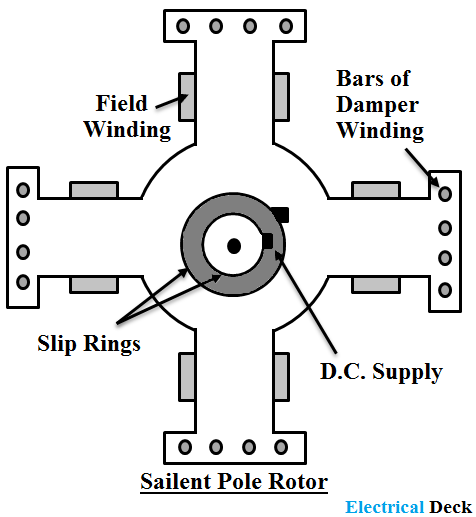As there is no constructional difference between dc generator and dc motor, similarly, there is no difference between the construction of a synchronous motor and a synchronous generator (alternator).
The construction of a synchronous motor is basically similar to the alternator of a rotating magnetic field type. It consists of two main parts, stator, and rotor.
Stator of Synchronous Motor :
- It is a stationary part of a machine.
- The armature winding is placed on the stator and so it is called stator winding.
- The stator consists of a cast-iron frame, which supplies the armature core or stator core having slots on its inner periphery for housing the armature conductors.
- The stator core is build-up with sheet steel laminations to reduce the eddy current losses.
- Ventilating ducts are provided in the frame for cooling the machine.
- The stator winding is a 3-Φ distributed winding excited by a 3-Φ ac supply.
Rotor of synchronous motor :
- It is a rotating part of a machine.
- Rotor carries a field winding which is supplied with direct current through two slip-rings.
- Rotors are two types namely,
- Salient pole type or projecting pole type.
- Non-salient pole type or smooth cylindrical type.
- Practically most of the synchronous motors are used salient pole type construction.
- Salient pole type or projecting pole type.
- Non-salient pole type or smooth cylindrical type.
Salient Pole Type Rotor :
- It has a large diameter and short axial length.
- Poles are projecting out of the rotor surface.
- Air gap is nonuniform.
- The poles are laminated and carry the field winding.
- The individual field pole windings are connected in series. The field winding is excited through a dc supply from the slip-rings provided on the rotor.
- The pole faces are usually provided with slots for damper winding or squirrel-cage winding.
- The damper bars are short-circuited at both ends by copper rings.
- The function of damper winding is to develop starting torque and prevents hunting in a synchronous motor.
Non-Salient Pole Type Rotor :
- It has a small diameter and a very long axial length.
- The rotor consists of a smooth solid forged steel radial cylinder having a number of slots along the outer periphery.
- Field windings are embedded in these slots and are connected in series to slip-rings through which they are excited by dc supply.
- Air gap is uniform.
As we see in the dc machines, the field winding which is stationary is kept on the stator, and the armature winding is rotating in on the rotor.
But in synchronous machines, it is reversed where the armature is kept stationary and the field winding will be at rotating. This type of synchronous machine construction has more advantages than dc machines type synchronous machine construction and it has limited applications.



